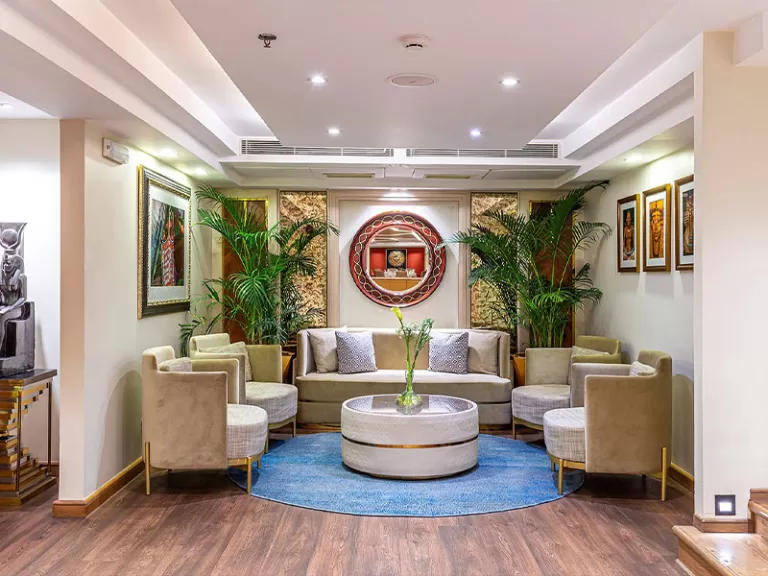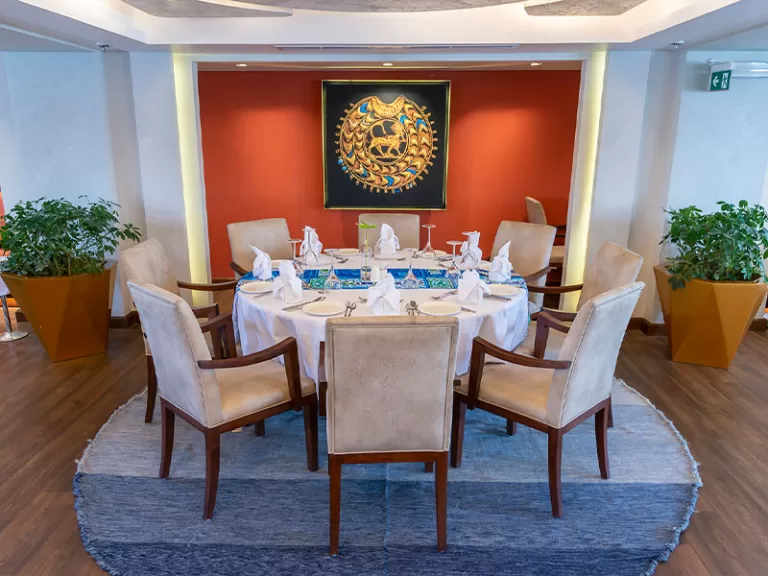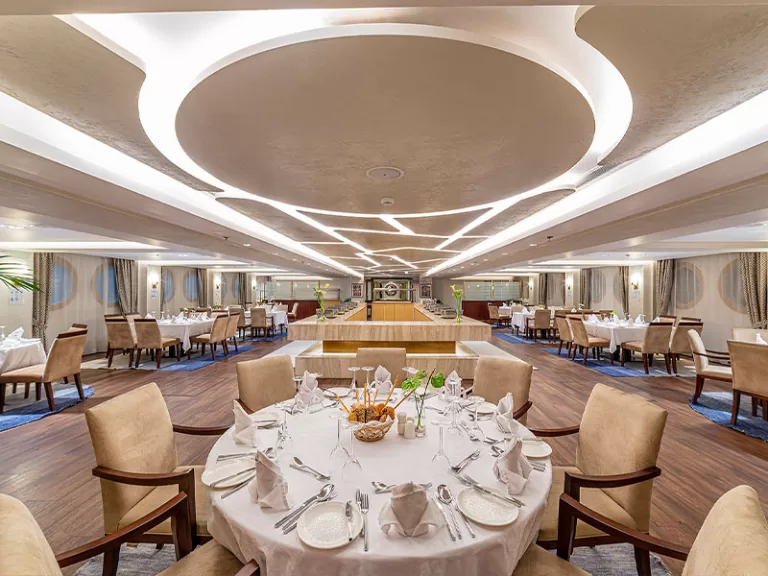

Home » Weekly Blog » Exploring the Enigmatic Temple of Khonsu
Welcome to a journey through time and history as we delve into the mysteries and wonders of the Temple of Khonsu. Nestled within the vast and awe-inspiring Karnak Temple Complex in Luxor, Egypt, this remarkable temple is a testament to the grandeur and spiritual significance of ancient Egyptian architecture.
The Temple of Khonsu, dedicated to the god Khonsu, occupies a unique place in the annals of ancient Egyptian history. Its construction and religious significance provide invaluable insights into the beliefs, rituals, and artistic prowess of this ancient civilization.
In this blog post, we will unravel the layers of history that enshroud the Temple of Khonsu, exploring its architectural marvels, religious significance, preservation efforts, and the profound cultural and artistic influence it has had over the ages. Whether you’re an avid traveler, history enthusiast, or simply curious about the ancient world, join us as we embark on an enlightening journey through the Temple of Khonsu and discover the timeless mysteries it holds.

To truly appreciate the Temple of Khonsu, it’s essential to understand the significance of the deity to whom this temple is dedicated. Khonsu, often referred to as “Khons,” was a lunar deity in ancient Egyptian religion. He was the god of the moon, time, and youth, and his iconography typically depicts him as a youthful figure with a sidelock of hair, holding a crook and flail. Khonsu was not only associated with the moon but also with healing and the measurement of time, making him a multifaceted and revered god in the Egyptian pantheon.
The Temple of Khonsu was built during the New Kingdom era of ancient Egypt, one of the most illustrious periods in Egyptian history. Specifically, it was constructed during the 20th Dynasty of the New Kingdom, around 1180 BCE. Located within the magnificent Karnak Temple Complex in Luxor, the Temple of Khonsu was strategically positioned to be an integral part of the larger religious landscape. This period was characterized by ambitious construction projects, and the temple’s architecture and purpose reflect the prosperity and devotion of the time.
The New Kingdom era was a time of immense cultural and political significance in ancient Egypt. It marked the height of the pharaonic civilization and saw the construction of some of the most iconic temples, monuments, and tombs in Egyptian history. Notable pharaohs like Ramses II and Amenhotep III ruled during this era, and their reigns were marked by great achievements in art, architecture, and military conquests. The construction of the Temple of Khonsu is a testament to the flourishing power and religious fervor of this period, and its rich historical context provides essential background for understanding the temple’s enduring legacy.
The Temple of Khonsu is a striking example of ancient Egyptian temple architecture. Its design and layout follow the traditional plan of Egyptian temples, which typically included an entrance pylon, a courtyard, a hypostyle hall, and a sanctuary. As you approach the temple, you’ll be greeted by the imposing entrance pylon, adorned with monumental gateways and intricately carved reliefs. The pylon represents the boundary between the mundane world and the sacred space within.
Once inside, the temple’s layout unfolds with a courtyard leading to a hypostyle hall. The courtyard, with its open-air design, was a place for worshippers and priests to gather for religious ceremonies. The hypostyle hall is a fascinating architectural feature characterized by its forest of towering columns, each intricately decorated with hieroglyphs and depictions of the god Khonsu.
What sets the Temple of Khonsu apart are its unique and well-preserved architectural elements. The walls of the temple are adorned with finely detailed bas-reliefs, showcasing scenes of religious rituals, offerings, and mythological stories. These intricate carvings provide valuable insights into the religious beliefs and practices of the time.
One remarkable feature of the temple is the presence of multiple barque shrines. These small chapels were used to house the sacred barques or boat-shaped shrines that carried the god’s image during processions. The presence of these shrines reflects the temple’s role as a center for religious ceremonies and the veneration of Khonsu.
The Temple of Khonsu is just one part of the vast Karnak Temple Complex, a sprawling temple city dedicated to the Theban Triad of Amun, Mut, and Khonsu. Within this complex, the Temple of Khonsu served as a vital component, focusing specifically on the worship of Khonsu. The temple’s location and design were purposefully integrated into the greater complex, emphasizing the interconnectedness of the deities and their roles in the ancient Egyptian pantheon.
Visiting the Temple of Khonsu not only allows you to admire its architectural splendor but also provides a window into the larger religious and cultural landscape of ancient Egypt during the New Kingdom era. In the next section, we will delve into the religious significance of this sacred place and the rituals performed within its hallowed walls.

The Temple of Khonsu was a place of profound religious significance in ancient Egypt, where various rituals and ceremonies were conducted to honor the god Khonsu. The temple served as a hub for the worship of this lunar deity and played a pivotal role in the religious life of the region. Priestly rituals included offerings, incense, and chants, all designed to appease and invoke the favor of Khonsu.
One of the most important ceremonies held at the temple was the Feast of Khonsu. During this annual event, the statue of Khonsu was taken from the inner sanctuary and paraded around the temple grounds in a grand procession. The festival was a time of celebration, prayer, and offerings to the god, and it attracted pilgrims and devotees from all over Egypt.
Khonsu’s role in Egyptian mythology was multifaceted. As the god of the moon, he was associated with timekeeping, as the lunar phases provided an early method of tracking time. Khonsu was also believed to have healing powers, and he was often invoked for cures and protection from illness. In a broader religious context, Khonsu was considered a benevolent deity who provided blessings and guidance to those who sought his favor.
The Temple of Khonsu, therefore, served as a place where the ancient Egyptians could seek divine intervention, healing, and blessings. Its religious significance extended beyond the temple walls, influencing the lives of the people who lived and worshipped in the surrounding communities.
In Egyptian religion, temples were not just places of worship during one’s earthly life but also held significance in the afterlife. The offerings and rituals performed at the Temple of Khonsu were believed to ensure the deceased’s successful journey into the afterlife. Many tombs in the vicinity of the temple feature inscriptions and images of Khonsu, highlighting the deity’s role in guiding the deceased to a favorable outcome in the afterlife.
The Temple of Khonsu, with its religious ceremonies and cultural importance, offers a glimpse into the spiritual world of the ancient Egyptians. As we continue our exploration, we’ll uncover the efforts to preserve and restore this magnificent temple, ensuring that it remains a window to Egypt’s ancient past.
The Temple of Khonsu, like many ancient structures, has faced numerous challenges over the millennia. From the moment of its construction in the New Kingdom era, the temple was exposed to the elements and natural wear and tear. Wind, sand, and sun, as well as the occasional flooding of the Nile, took their toll on the temple’s delicate carvings and structures.
Additionally, the passage of time brought human intervention, including vandalism, theft, and modifications by various civilizations. These factors collectively posed significant threats to the temple’s preservation, making its ongoing protection a complex and multifaceted endeavor.
Recognizing the importance of the Temple of Khonsu as a historical and cultural treasure, modern conservationists, archaeologists, and organizations have taken significant steps to ensure its preservation. Restoration projects have been undertaken to stabilize the temple’s structure, repair damaged reliefs, and protect it from further deterioration.
These efforts involve meticulous research, careful documentation, and the use of advanced technologies to restore the temple while preserving its authenticity. Such projects not only safeguard the physical integrity of the temple but also enhance our understanding of ancient Egyptian architecture and art.
In 1979, the Temple of Khonsu, along with the entire Karnak Temple Complex, was inscribed on the UNESCO World Heritage List. This international recognition has brought global attention to the importance of preserving this ancient site. UNESCO’s designation highlights the need for continued efforts in conserving the temple, not only for the benefit of current generations but also for the enjoyment and education of future ones.
By addressing the challenges of preservation and restoration, we ensure that the Temple of Khonsu remains a living testament to the remarkable achievements of the ancient Egyptians and their devotion to the gods. The temple stands not only as an architectural marvel but also as a bridge connecting us to a rich and vibrant past. In the next section, we’ll explore what visitors can expect when they venture to this remarkable site and the cultural and artistic significance it holds.
Situated within the sprawling Karnak Temple Complex in Luxor, Egypt, the Temple of Khonsu is a must-visit destination for history enthusiasts, archaeology buffs, and curious travelers. Its convenient location in Luxor, often referred to as the “world’s greatest open-air museum,” makes it easily accessible for visitors from all over the world.
The temple is just a short distance from Luxor’s city center, and many tour operators offer guided visits to the complex. The journey to the temple is an experience in itself, as you traverse through the stunning landscape of the Nile Valley, surrounded by lush vegetation and the remnants of ancient Egypt.
When exploring the Temple of Khonsu, there are several key areas and features that you should not miss:
The Entrance Pylon: The monumental gateway, adorned with hieroglyphs and reliefs, serves as the dramatic entry point to the temple.
The Courtyard: This open area was once a bustling hub of religious activity, where offerings and ceremonies were performed.
The Hypostyle Hall: Step into the magnificent hypostyle hall, with its towering columns and beautifully preserved carvings. Take a moment to appreciate the intricate details that tell stories of ancient Egypt.
Barque Shrines: Explore the small chapels that housed the sacred barques of Khonsu and learn about their role in religious processions.
Reliefs and Carvings: Examine the temple’s walls to decode the hieroglyphic messages and scenes that depict ancient Egyptian life and beliefs.
To make the most of your visit to the Temple of Khonsu, consider these practical tips:
Tour Guide: Hiring a knowledgeable tour guide can greatly enhance your experience. They can provide historical context and help you decipher the temple’s intricate carvings.
Respect and Preservation: Remember to treat the site with respect. Avoid touching or leaning on the ancient carvings, as this can contribute to wear and tear.
Weather and Timing: The climate in Luxor can be quite hot, so plan your visit during the cooler morning or late afternoon hours. Don’t forget to stay hydrated and wear appropriate sun protection.
Photography: Capture the beauty of the temple, but be mindful of any restrictions on photography and flash usage. Some areas may be sensitive to light exposure.
Souvenirs: You can often find souvenirs and books related to the temple at the site’s visitor center. These can be wonderful keepsakes to remember your visit.
Exploring the Temple of Khonsu is not only an opportunity to connect with ancient history but also a chance to be captivated by the enduring beauty and spirituality of this sacred place. As you wander through its hallowed halls, you’ll gain a deeper appreciation for the profound impact of Egyptian culture and artistry. In the following section, we’ll dive into the cultural and artistic significance of the temple, shedding light on its influence on the broader tapestry of Egyptian history.
The Temple of Khonsu is not merely a religious site; it is a repository of ancient Egyptian art and culture. Its walls are adorned with a rich tapestry of artistic representations and hieroglyphics that provide a window into the daily life, beliefs, and mythology of the time.
The intricate carvings and reliefs depict scenes of offerings to the gods, ritual ceremonies, and the veneration of Khonsu. You’ll also find depictions of pharaohs, priests, and various gods from the Egyptian pantheon. These artistic representations are not just ornamental; they convey a deeper understanding of the spiritual significance of the temple and its role in Egyptian society.
The Temple of Khonsu, like many other ancient Egyptian temples, played a crucial role in shaping the artistic and cultural landscape of the time. The art and inscriptions found within the temple had a lasting impact on the development of Egyptian art, especially in the New Kingdom period.
These artistic elements were not limited to temples alone but also influenced other forms of expression, including tomb art, jewelry, and pottery. The iconography and symbols associated with Khonsu and the rituals performed in his honor left an indelible mark on the artistic heritage of Egypt.
For archaeologists, historians, and Egyptologists, the Temple of Khonsu is a treasure trove of information. The carvings and inscriptions have provided invaluable insights into the religious beliefs, social structures, and daily life of ancient Egyptians. The study of these artifacts has expanded our knowledge of the civilization that flourished along the banks of the Nile for thousands of years.
Furthermore, the Temple of Khonsu and similar ancient sites have fostered an appreciation for the importance of preserving cultural heritage. By understanding the significance of these structures, we are reminded of the need to protect and cherish our shared human history.
In conclusion, the Temple of Khonsu transcends its religious function to become a masterpiece of art, a testament to cultural exchange, and a key to unlocking the mysteries of ancient Egypt. As we wrap up our exploration of this remarkable temple, it’s evident that its impact extends far beyond the boundaries of Luxor, reaching into the hearts and minds of all those who are fortunate enough to visit and study it.
In our journey through the Temple of Khonsu, we’ve uncovered the layers of history, spirituality, and artistry that make this ancient Egyptian temple a truly enigmatic and captivating destination. From its rich historical background to its architectural marvels, religious significance, and modern preservation efforts, the Temple of Khonsu stands as a testament to human achievement and enduring devotion.
As we’ve explored the temple’s cultural and artistic significance, we’ve discovered how it has not only shaped the artistic landscape of ancient Egypt but also contributed to our understanding of this remarkable civilization. The carvings and inscriptions within its walls continue to whisper the stories of the past, preserving a connection between us and those who walked these hallowed grounds thousands of years ago.
Visiting the Temple of Khonsu is not just a journey into the past but an opportunity to stand in awe of the ingenuity, faith, and creativity of the ancient Egyptians. It’s a reminder of the importance of preserving our cultural heritage and of the power of these ancient structures to inspire and enlighten.
Whether you’re planning a trip to Luxor or simply intrigued by the wonders of the ancient world, the Temple of Khonsu beckons you to explore its mysteries and immerse yourself in the captivating history it holds. As we conclude our exploration, we invite you to embark on your own journey to this remarkable site and witness the enduring legacy of Khonsu’s temple for yourself.
Sign up to hear about our upcoming adventures, monthly newsletter, exclusive offers, and more!
Required*
Not Ready to book?
Get regular updates on upcoming tour and special promotions.







Sign up for our Mailing List to get updates on our current offerings.